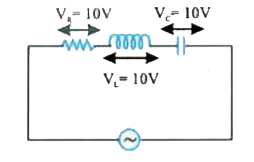Assertion: In series, L-C-R voltage across capacitor is always less than the applied voltage.
Reason: In series L-C-R circuit, V=√(V2+(V2L−V2C))
If both Assertion and Reason are true and Reason is the correct explanation of Assertion.
If both Assertion and Reason are true but Reason is not the correct explanation of Assertion.
If Assertion is true but Reason is false.
If Assertion is false but Reason is true.
The correct Answer is:D
d) VR←V, but VC or VL can be greater than V also.
Similar Questions
Knowledge Check
In terms of q, the voltage equation for series L-C-R circuit is given by
ALdqdt=Rdqdt+q/C=VmsinωtBLd2qdt2+Rdqdt+q/C=VmsinωtCLd2qdt−Rdqdt+q/C=VmsinωtDLd2qdt−Rdqdt−q/C=VmsinωtAssertion: In series L−R circuit voltage leads the current.
Reason: In series L−C circuit leads the voltage.AIf both the assertion and reason are true and reason is a true explantion of the assertion.BIf both the assertion and reason are true but the reason is not true the correct explantion of the assertion.CIf the assertion is true but reason falseDIf both the assertion and reason are false.In series LCR circuit, the voltages across R, L and C are shown in the figure. The voltage of applied source
 A110 VB10 voltC50 voltD70 volt
A110 VB10 voltC50 voltD70 volt
In series L-C-R circuit as shown in figure the voltage of the source is

View SolutionIf a voltage V is applied across the bulbs in series, then
View SolutionAssertion: In an AC circuit, potential difference across the capacitor may be greater than the applied voltage.
Reason : VC=IXC, wheereas V=IZ and XC can be greater than Z also.
View SolutionIn series LCR circuit, the voltages across R, L and C shown in figure. The voltage of applied source is

View SolutionIn an LCR series circuit the voltages across R,L and C at resonance are 40Vand60V respectively the applied voltage is .
View Solution

